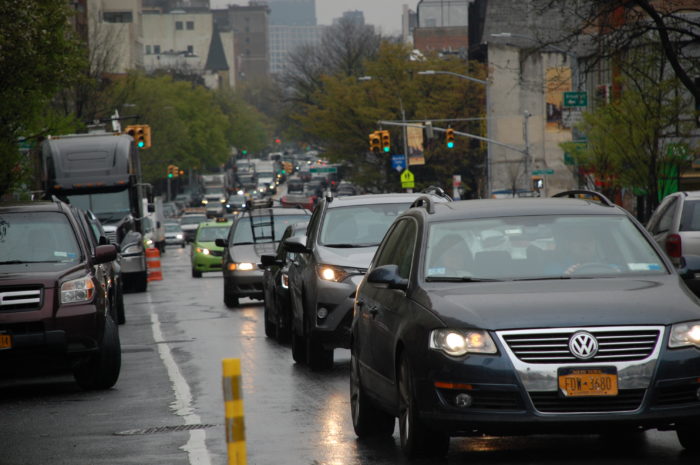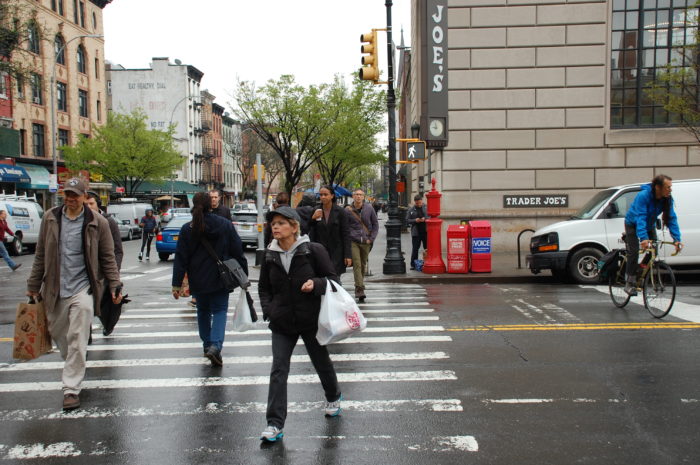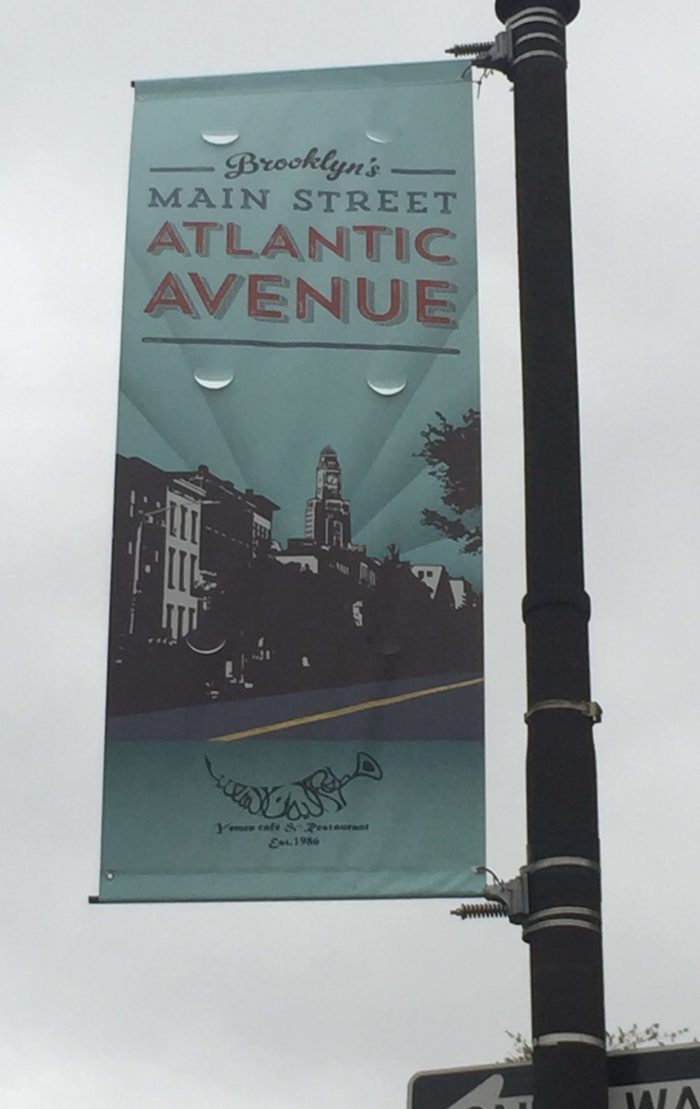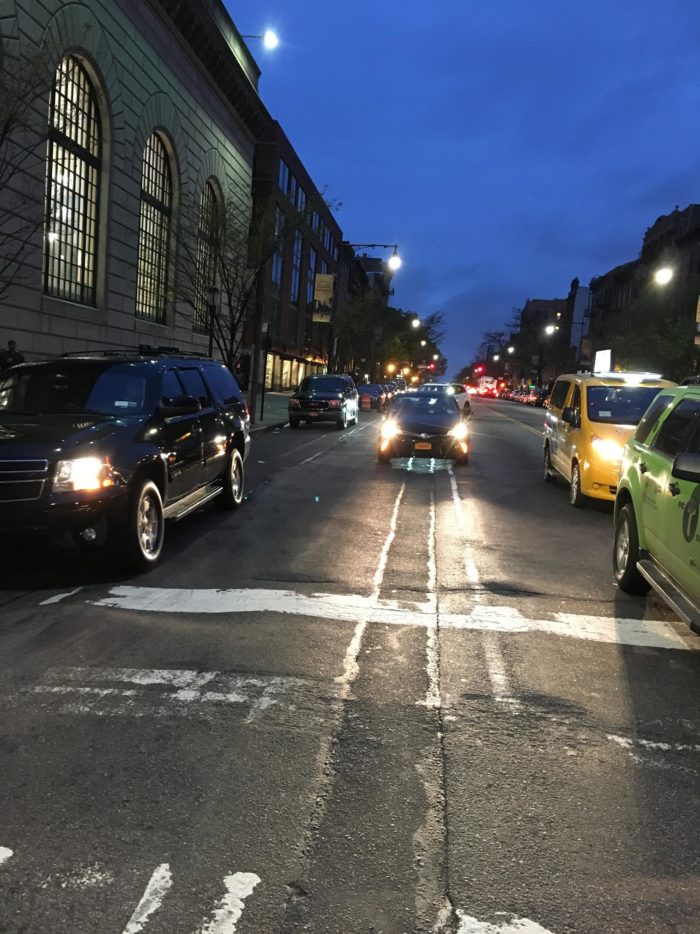How Deadly Atlantic Avenue Is About to Get Safer
Brooklyn's busiest business corridor will receive $5 million in improvements for bikers and pedestrians
Near its intersection with Court Street, Atlantic Avenue often seems more like a freeway than a surface street (Photo by Steve Koepp)
The business corridor of Atlantic Avenue calls itself “Brooklyn’s Main Street” and serves as the stage for the borough’s biggest street fair, Atlantic Antic. But it has a dual reputation as a thoroughfare of danger. The avenue is among the borough’s deadliest for pedestrians and bicyclists because of its complicated intersections, lack of protected bike lanes, and intense volume of traffic. “Since 2012, more than 3,300 people have been injured and 26 have been killed on the corridor,” declared a report last year by Transportation Alternatives, which advocates for bikers and pedestrians.
In a gruesome crash in 2015 involving three cars, a cyclist was killed and six people were injured in a wreck at Atlantic and Fourth Avenue. That same year, the longtime owner of Oriental Pastry & Grocery, Muyassar Moustapha, was struck and killed as he dashed across Atlantic to pick up ice cream. For bike riders, Atlantic is a road to be shunned. “I’m a pretty experienced cyclist and I think twice about choosing Atlantic even when it’s the most direct route,” said Traci Strickland, a resident of the South Slope, who recalled a moment when a truck made an abrupt right turn in front of her and nearly pushed her off the road.

Pedestrians and bikers dash across Atlantic at Court Street (Photo by Steve Koepp)
Now relief is coming. Governor Cuomo announced on Wednesday that $112 million in funding has been awarded to 81 projects statewide to make the state’s streets safer for bicyclists and pedestrians, among other improvements. New York City will get $16 million and Brooklyn will get the lion’s share of that, $10 million for two projects. Each project had to petition for the money and the winners were chosen by need and merit. The funding, which will cover up to 80% of each project, is allocated by the Federal Highway Administration and administered by the state. The federal investment, said Senator Charles Schumer in a statement, will “encourage New Yorkers to travel more by bike or by foot. Increased biking and walking is good for our collective hearts and lungs; it also reduces congestion and helps boost the economy.”
Half of Brooklyn’s money will go toward the second phase of rebuilding the intersection of Tillary and Adams streets, which serves as a gateway for bikers and pedestrians crossing the Brooklyn Bridge. What is now a grim corridor of concrete barriers will be turned into a welcoming greenway.
But the more dramatic changes for Brooklynites may come from the $5 million allocated to making Atlantic Avenue less fearsome. Brookynites interviewed by The Bridge after Cuomo’s announcement applauded the news. “I think it’s a wonderful plan. I’m all for it,” said restaurateur Doug Crowell, owner of French Louie at 320 Atlantic Ave. and Buttermilk Channel in Carroll Gardens. “Over the past five years, Atlantic Avenue has transitioned from an access road to the BQE into a true avenue for people. It’s still a dangerous street, though, and I think it would benefit both residents and business owners to make Atlantic a more pedestrian and bicycle friendly place.”
A Borough’s Biking Boom

Atlantic Avenue merchants call the strip “Brooklyn’s Main Street” (Photo by Steve Koepp)
Indeed, the state of Atlantic Avenue seems incongruous with the borough’s changing lifestyle. Brooklyn may not be Amsterdam when it comes to commuting via bicycle, but it’s getting there as bike lanes fill up with commuters on Citi Bikes and millennial speedsters on their fixed-gear rigs. While the rates of bicycle injuries have declined in the city in recent years, the vastly increased ranks of riders mean that a conspicuous number have had fatal encounters with motor vehicles. The first eight months of 2016 saw the number of riders killed in New York City exceed the total for all of 2015; eight of those riders were in Brooklyn, according to the city Transportation Department. The statistics show that despite the addition of bike lanes and other enhancements, more needs to be done to pursue one of Mayor Bill de Blasio’s signature efforts: Vision Zero, a plan to eliminate traffic deaths in the city by 2024.
The big change in this project would be addition of protected bike lanes. Manhattan has 120 miles of bike lanes, vs. only 80 for Brooklyn, which has more riders. Atlantic Avenue is a 10-mile corridor with virtually no protection. “I don’t bike on Atlantic because I don’t think it’s safe. I would like protected bike lanes,” said Amy Sirot, a Cobble Hill resident and parent coordinator at a nearby middle school.
Welcome Barriers to Entry
The key word is “protected.” As bikers know, merely painting lines on the street offers limited help. The lanes wind up getting used by double-parkers, delivery trucks and even pedestrians avoiding crowded sidewalks. A protected bike lane has physical barriers to prevent such incursions. According to the Department of Transportation, since the implementation of protected bike lanes a decade and a half ago, bike accidents are down overall by 17%, risk of serious injury to cyclists is down 75%, and contrary to what motorists might believe, traffic congestion hasn’t got any worse since the lanes were installed.

The rain-slicked Atlantic Avenue during the evening rush hour (Photo by Lesley Alderman)
Atlantic Avenue is not just a safety problem, it’s class issue as well, according to a Transportation Alternatives report last December titled “Atlantic Avenue’s Inequitable Crash Burden.” While the west end of Atlantic traverses wealthier neighborhoods like Brooklyn Heights and Boerum Hill, as the avenue heads eastward, it traverses poor sections of the borough. “On average, more than a quarter of the population residing near Atlantic lives in poverty,” said the report. Poorer neighborhoods tend to have a higher rate of crashes than wealthy ones, noted the report, adding that poorer parts of the city “more often suffer from inadequate urban planning and a lack of infrastructure investment.”
What can be done, besides those bike lanes? Many physical improvements can protect pedestrians too. Last December, at a particularly long (80 ft.) pedestrian crossing at Atlantic and Fourth Avenues, the city Transportation Department installed a rubber traffic island as a pilot project to create a safer, two-part pedestrian crossing. With $5 million in funding, expect more such physical solutions on Atlantic.
Despite all that, many Brookynites would say that a burden still falls on bikers and hikers to look out for themselves. Gloria Truppi, a Carroll Gardens resident who has been biking on city streets for 22 years, thinks too many New Yorkers just don’t pay attention. “We’re professional jaywalkers here,” she said, pausing in a bike lane at Atlantic and Clinton. “Nobody looks!”
Angelica Frey and Steve Koepp contributed additional reporting for this story










